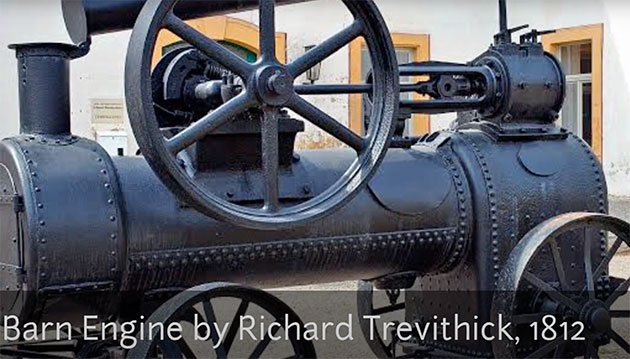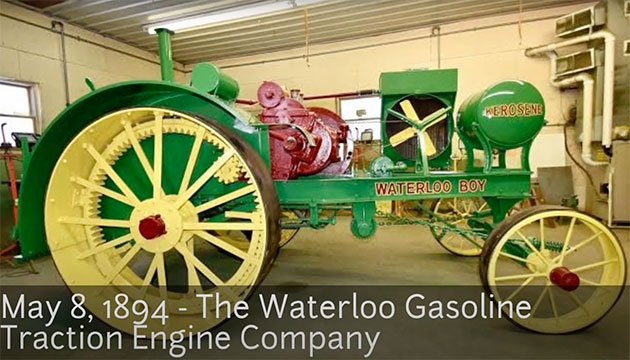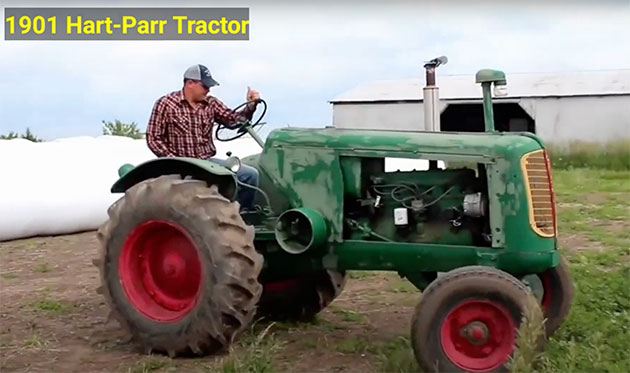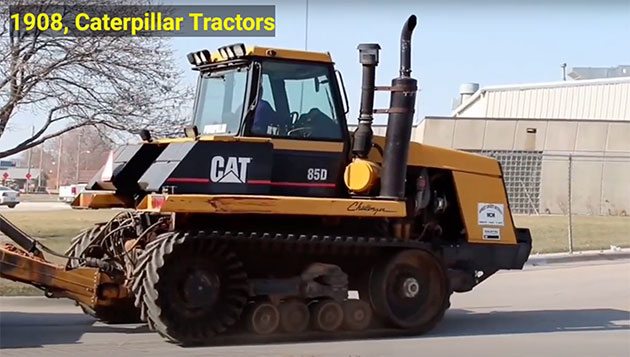A farm tractor is a piece of powerful agricultural machinery that replaces animals and manual work in all agricultural and farming tasks.
Nowadays, we cannot imagine American farmers without farm tractors & their superiority.
Of course, with the development of modern technology, the tractor industry also improved, so tractor production became more advanced.
Thus, today, we have versatile tractors and high-quality farm implements necessary for all lighter and heavy-duty tasks.
But, what are the first tractor beginnings, who invented tractors, and how did the farm machinery change the farm history?
Read below about the history of tractors and old tractor brands.
Table of Contents
Who Invented Tractors? The 19th-Century Beginning

The tractor history properly begins with the invention of steam power.
Namely, the A. M. Archambault & Company of Philadelphia made the first farm steam engine in 1849.
However, the steam engine was later improved and updated to become a steam traction engine with steering capabilities and powered wheels.
Finally, it was used for operating threshing machines.
Although the steam engines were portable or stationary, later, the manufacturers came up with traction engines, machines with powered wheels, allowing drivers to steer them from cabins or platforms.
The steam traction engines were also crucial for operating on the threshing machine.
However, the steam engine was cumbersome, costly, and unwieldy for many farmers.
So, in 1876, the German inventor Nicholas Otto invented the Otto reliable internal combustion engines.
The tractor motor is famous for the four-stroke principle numerous four-wheel-drive tractors use today.
And they were more successful than the steam traction engines.
Following Otto’s example, multiple tractor companies started the engine business, with more than 100 Otto-type engines after the 1890s.
And the internal combustion engine models were the most popular engine types.
And during this period, it was time for gasoline tractors to make their debut to replace the steam tractors on the scene.
Hence, the internal combustion engine was replaced by the gasoline engines.
So, officially, the first tractor invented was the gas-powered tractor by John Froelich in 1892. John Froelich was a tractor inventor living in a small village in Iowa.
He started a tractor revolution, as before his invention, farmers could only rely on steam-powered engines for plows.
However, these steam-powered engines were too slow, hard to move between the obstacles, and, more vitally, the steam engines were prone to explosions.
That’s why Froelich came up with the beautiful idea to use a gas-powered tractor as the engine would not be prone to explosion and would be effortless to perform and maneuver well.
So, the first tractor model became an instant success.
Not long after Froelich’s invention, gasoline-powered tractors became more popular on the tractor market, as gasoline was a commonplace fuel during the late 19th century.
Hence, various gasoline tractors and traction engines using gas appeared on the tractor market.
However, Froelich’s gasoline engine model was the first farm machinery with forward and reverse gears. But he didn’t stop here.
As a successful inventor, Froelich went a step further and connected the first gasoline tractor to a thresher during harvest in South Dakota.
Again, the experiment succeeded – the tractor effortlessly threshed the wheat.
But, although the steam engines and steam power were desired, they didn’t have the wanted quality necessary for operations.
So, Froelich’s threshing machine had to be more advanced. Hence, he decided to update it.
This way, Froelich fathered an extended line of stationary gasoline engines, resulting in the famous John Deere two-cylinder tractor model.
Stationary engines changed the industry once again.
Still, by the end of the 19th century, the early tractors used brand-new gas engines.
The gas tractor field flourished with the latest designs made by two engineering students at the University of Wisconsin.
In 1897, Charles Parr and Charles Hart founded the Hart-Parr Gasoline Engine Company in Madison, Wisconsin, and shifted the production to Iowa near the end of the century.
So, in 1901, the partners produced the first successful North American tractor for agricultural and farming tasks.
The two co-founders also coined the word tractor from the term traction engine.
Their first tractors were expensive and large, with huge steel wheels.
Farm Tractor Production: The 20th-Century Continuation

As John Froelich managed to expand in 1849, he founded the Waterloo Gasoline Traction Engine Company with four prototype tractors.
However, he later branded himself, while Waterloo continued the production of the Waterloo gasoline engine in the 1900s.
The John Deere tractor company now owns the Waterloo Boy tractor company.
At the beginning of the century, Canada was the leader in the tractor market.
Thus, in 1908, they had numerous companies manufacturing tractors and hosted different plowing contests to help others clear their land.
Still, as they were very fond of mechanical farm machinery and used them as necessary farm equipment, the first tractors were not that popular within the first decades of the 20th century in America.
But, as the farmers learned the benefits and advantages the machinery offered, including better performance, time-consuming operations, successful results, effective and efficient jobs, the farm power increased, and the tractor business blossomed.
Hence, in 1904, in California, farmers used crawler tractors.
They replaced the cumbersome caterpillars, and their invention was primarily focused on earth-moving operations.
So, these tractors marked another beginning in tractor machinery and use.
Farmers realized there was no need for manual work and hard labor when they had powerful machinery to replace them.
So, during the period between 1910 and 1970, the tractor business drastically improved and increased, from approximately 1,000 tractor sales to almost 5 million tractor sales.
The main reason for such success was the fall of the tractor prices.
For instance, in 1920, the tractor prices were around $785. Yet, in 1922 they drastically dropped so that farmers could purchase the machines for only $395.
Thus, in 1910, the International Harvester was the leading producer of the tractors.
In 1912, International Harvester, Hart-Parr, and Rumely produced around 10,000 tractors.
However, 1914 was crucial for the Canadian market, as the big tractors radically decreased, so the tractor builders realized they had to produce smaller machines.
So, in 1913, the Bull Tractor Company of Minneapolis started the tractor development for smaller farms and farmers.
So, the first small tractor was produced.
The machine was famous for its bull-wheel and the unpowered “idle” wheel.
The two parts provided balance and were located on a crank axle. So, the tractor could run and operate effortlessly for excellent performance and more advanced operations.
In addition, the Bull had a two-cylinder gasoline engine of 12 horsepower. The small tractor weighed only 3,000 pounds and sold for the meager price tag of $395.
And, a few years later, the Bull tractors completely outpowered the International Harvester with the tractor sales even with much larger tractors.
However, during World War I and World War II, tractor production sharply decreased and increased again after the wars, which marked a considerable change in the tractor business.
Thus, the International Harvester was again the leader on the market, followed by Moline, Avery, and Case.
Henry Ford entered the field with the Fordson tractor at the end of World War I.
And even Cyrus McCormick III, the head of the International Harvester, wrote about Ford.
The first experiment Ford invented was a gasoline tractor in 1907, referred to as the automobile plow, as they didn’t use the precise word tractor.
However, Ford also contributed much to the tractor’s history and development.
In the following years, Ford and International Harvester ruled the market by mass production of tractors and their price war.
However, both companies overpassed the competitors by producing cheaper, more versatile, and lightweight tractors.
Still, the competition made the International Harvester rapidly standardize their parts and adopt automotive production methods.
Advantages such as PTO, belt speeds, and spline sizes only made farmers drive mechanical farm machinery efficiently and marked the new tractor era.
So, thanks to Henry Ford and International Harvester, our modern tractors nowadays have maximum versatility and flexibility for the most effortless and quickest operations and efficient tasks.
As modern technology and resources advanced, John Deere released the 1918 Waterloo Boy tractor, running on kerosene.
John Deere started tractor sales as the company purchased Waterloo Gasoline Engine in 1918.
Also, the John Deere Waterloo Boy was one of the first models successfully utilizing the combustion engine.
And, as it ran on kerosene, the Waterloo Boy tractor was user-friendly, as kerosene was available in stores.
Thus, the John Deere Waterloo Boy marked another revolution in the tractor world.
However, the John Deere company went a step further and moved the tractor borders once again in 1923.
As you can find, that was the year the John Deere Company introduced their famous John Deere Model D.
The John Deere Model D replaced the Waterloo Boy.
So, once again, the John Deere tractor factory took its rightful place on the tractor market and became the leader.
However, even today, John Deere is one of the leading tractor brands with exceptional models and multifunctional tractors.
But, during the period between 1925 and 1932, the International Harvester introduced the Farmall tractor.
The Farmall tractor changed the way farmers raised crow crops.
The Farmall tractors had small front wheels, high clearance, and a lightweight design for cutting, plowing, and cultivating.
And in 1939, the company introduced the second Farmall tractors series. The series included A and B – small-sized, H – middle-sized, and M – large-sized tractor models.
However, in 1927 John Deere once again crushed the competition by releasing a power lift.
It was a mechanism allowing the implement to be raised by pulling a lever instead of lifting the tool by hand at each turn.
Also, during the same period, rubber tires completely replaced the steel wheels, as they increased the speed and reduced the damage in the fields.
Finally, the biggest highlight is the invention of lower-cost diesel engines, as they became the primary type in the 1930s.
And, in the last years of the fourth decade, Henry Ford made a huge comeback through its partnership with Henry Fergusson.
Fergusson created a three-point hitch mechanism, the same system the modern agricultural tractor uses even today.
The technology allowed a piece of more complex machinery and implements to be attached to the tractor’s ends, not just stationary equipment.
After 1932, a lot of farmers used various GP tractors.
More than a million of these tractors were sold by the three most outstanding companies, including John Deere, International Harvester, and Allis-Chalmers.
The GP tractors will not change their horsepower and size, only their design and shape, but those changes were minor.
And by the 1940s, tractors successfully replaced people, horses, and mules on farms.
Thus, mass production was the central turning point and the peak in the tractor industry, as the farmers could harvest more crops, and the manufacturers could boost their production significantly.
However, it wasn’t only America influenced by massive production between and after the two wars, but the rest of the planet as well.
So, we can testify to the production of European and Asian brands Lamborghini and Mahindra during the mid-20th century.
Thus, the Italian and Indian companies entered the tractor worlds and took over both international and domestic markets.
And even today, thanks to numerous researches from 2010 and on, Mahindra has been the best-seller among all tractor manufacturers.
Tractor Improvements: The Advanced 21st-Century Technology

Finally, the 21st century brought to use the latest technology advantages reflected on the tractors as well.
Thus, we can come across different tractor types, their multi-purpose benefits, and the most advanced designs.
Today’s tractors include all models – from utility to row crops to 4WD models, and they have come a long way in the last 100 years.
So, the brand-new models are equipped with the latest technology improvements and updates.
These little revolutions include increased versatility and flexibility, greater horsepower, more potential, and strength.
However, the changes also reflect the luxurious and comfortable driver’s cabins, with air conditioning, GPS, and ergonomic design for comfort during long work hours.
But, the manufacturers don’t simply see the end of improvements, so they always add something new and create brand-new designs and sketches.
Hence, we can see different self-driving tractor models operated via other technological devices for better performance and the best efficiency.
And, as the various tractor models offer multiple possibilities, I’m confident you can undoubtedly find the best solution for your agricultural needs.
Thus, you can choose between multiple gardens, industrial, orchards, and other tractor types, depending on your needs.
However, the latest technological updates resulted in various electric or driverless tractors.
These units are famous for artificial intelligence and the primary source of “fuel” and operations.
And, in the future, humans won’t need to navigate and perform the tasks.
Thus, we can control them via different smartphones, computers, GPS drones, and satellites.
However, the process is still in half, as only dozens of the products operate without human interaction via single operators.
And, if you take a look at the latest John Deere’s improvements, you can find various autonomous and semi-autonomous tractors, autonomous sprayers and drone sprayers, eAutoPower transmission, and other ways of electrification.
So, the tractors really changed the farmers’ lives in the following terms:
- Efficiency – tractors have helped with consistency and speed, but GPS field navigation and crop yield monitors have also helped farmers to map the crop yields and soil quality across their farms. Thus, GPS devices help with crop management.
- Reduced workforce – reduced work hours and days helps cut down the fatigue, ability to meet deadlines, and allow more work in the fields.
- Increased revenues – by using tractors that utilize fuel, farmers can increase overall revenues and save more money, as it will cost more to take care of animals continually.
- More room for crops and less animal work – as you have to feed horses, mules, and other farm animals, it will cost you extra work and time. Also, animals cannot complete all work in extreme conditions. However, you may need to produce different land and crops for their food. But, with good tractors, you can save additional land for growing crops.
FAQs

When was the tractor invented?
Although the first tractors relate to the steam-powered models, the experts took the 1892 year as the office when the first tractor was introduced.
That was John Froelich’s gas-powered tractor, made in Iowa.
What is the oldest tractor brand?
The survived records point to the Charter Gas Engine Co, owned by John Carter.
According to the documents, the company made the first tractor in 1889.
Who made the first tractor in the world?
The first-ever made tractor was created and patented by the Charter Gas Engine Co, owned by John Carter.
As numerous written records testify, the company made the tractor in 1889, three years before John Froelich.
How have tractors changed over the years?
Firstly, they replaced hard labor and manual work and the extensive use of animals, especially mules and horses.
Secondly, they reduced the work hours and provided more strength, power, and efficiency to all farmers.
Next off, the tractors drastically changed the ways farmers cultivate the land for harvesting, planting, etc.
And, with the modern technology improvements, various types of tractors and multi-functions help the farmers finish their tasks easily and quickly.
How did farmers farm before tractors?
Before the tractors were invented, farmers relied on their own strength.
Moreover, they used various animals to prepare the land and work, such as horses, oxen, mules, and others.
But, it costs them a lot of time and energy.
What are the advantages and disadvantages of a farm tractor?
Some of the advantages include:
- more power and strength
- efficacy and potential
- versatility
- flexibility
- longer work hours with less energy and time consumption
- ease of transmission and operation
- durability and sturdiness
- different types of machinery and implements
Some of the disadvantages include:
- causing air pollution
- using fuel
- using chemicals
- require careful maintenance and clean fuel
Final Words
Nowadays, the word tractor represents the powerful machinery used for numerous agricultural jobs, from heavy-duty to lighter ones.
However, it also means an indispensable part of farmers’ lives and the tool to perform and operate on different land types.
So, we have seen the complete retrospective regarding the history of tractors (old tractor brands), their beginnings (who invented tractors), changes, and improvements throughout time, and are yet to wait for further development and technological advancements.
But, one thing is sure – tractors rule in the farm world, and the best is yet to come!
